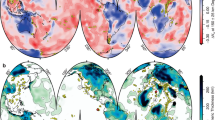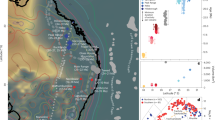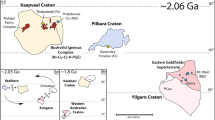Abstract
Hotspots are anomalous regions of volcanism at Earth’s surface that show no obvious association with tectonic plate boundaries. Classic examples include the Hawaiian–Emperor chain and the Yellowstone–Snake River Plain province. The majority are believed to form as Earth’s tectonic plates move over long-lived mantle plumes: buoyant upwellings that bring hot material from Earth’s deep mantle to its surface1. It has long been recognized that lithospheric thickness limits the rise height of plumes2,3,4 and, thereby, their minimum melting pressure. It should, therefore, have a controlling influence on the geochemistry of plume-related magmas, although unambiguous evidence of this has, so far, been lacking. Here we integrate observational constraints from surface geology, geochronology, plate-motion reconstructions, geochemistry and seismology to ascertain plume melting depths beneath Earth’s longest continental hotspot track, a 2,000-kilometre-long track in eastern Australia that displays a record of volcanic activity between 33 and 9 million years ago5,6, which we call the Cosgrove track. Our analyses highlight a strong correlation between lithospheric thickness and magma composition along this track, with: (1) standard basaltic compositions in regions where lithospheric thickness is less than 110 kilometres; (2) volcanic gaps in regions where lithospheric thickness exceeds 150 kilometres; and (3) low-volume, leucitite-bearing volcanism in regions of intermediate lithospheric thickness. Trace-element concentrations from samples along this track support the notion that these compositional variations result from different degrees of partial melting, which is controlled by the thickness of overlying lithosphere. Our results place the first observational constraints on the sub-continental melting depth of mantle plumes and provide direct evidence that lithospheric thickness has a dominant influence on the volume and chemical composition of plume-derived magmas.
This is a preview of subscription content, access via your institution
Access options
Subscribe to this journal
Receive 51 print issues and online access
$199.00 per year
only $3.90 per issue
Buy this article
- Purchase on Springer Link
- Instant access to full article PDF
Prices may be subject to local taxes which are calculated during checkout


Similar content being viewed by others
References
Morgan, W. J. Convection plumes in the lower mantle. Nature 230, 42–43 (1971)10.1038/230042a0
Davies, G. F. Thermomechanical erosion of the lithosphere by mantle plumes. J. Geophys. Res. 99, 15709–15722 (1994)
Farnetani, C. G. & Richards, M. A. Thermal entrainment and melting in mantle plumes. Earth Planet. Sci. Lett. 136, 251–267 (1995)
White, R. S. & McKenzie, D. Mantle plumes and flood basalts. J. Geophys. Res. 100, 17543–17585 (1995)
Cohen, B. E., Knesel, K. M., Vasconcelos, P. M., Thiede, D. S. & Hergt, J. M. 40Ar/39Ar constraints on the timing and origin of Miocene leucitite volcanism in southeastern Australia. Aust. J. Earth Sci. 55, 407–418 (2008)
Cohen, B. E., Knesel, K. M., Vasconcelos, P. M. & Schellart, W. P. Tracking the Australian plate motion through the Cenozoic: constraints from 40Ar/39Ar geochronology. Tectonics 32, 1371–1383 (2013)
Duncan, R. A. & Richards, M. A. Hotspots, mantle plumes, flood basalts and true polar wander. Rev. Geophys. 29, 31–50 (1991)
Steinberger, B. Plumes in a convecting mantle: models and observations for individual hotspots. J. Geophys. Res. 105, 11127–11152 (2000)
Courtillot, V., Davaille, A., Besse, J. & Stock, J. Three distinct types of hotspots in the Earth’s mantle. Earth Planet. Sci. Lett. 205, 295–308 (2003)
Campbell, I. H. & Griffiths, R. W. The changing nature of mantle hotspots through time: implications for the geochemical evolution of the mantle. J. Geol. 100, 497–523 (1992)
Wellman, P. & McDougall, I. Cainozoic igneous activity in eastern Australia. Tectonophys. 23, 49–65 (1974)
Johnson, R. W. (ed.) Intraplate Volcanism in Eastern Australia and New Zealand Ch. 1.1 (Cambridge Univ. Press, 1989)
Knesel, K. M., Cohen, B. E., Vasconcelos, P. M. & Thiede, D. S. Rapid change in drift of the Australian plate records collision with Ontong Java plateau. Nature 454, 754–757 (2008)
Sutherland, F. L., Graham, I. T., Meffre, S., Zwingmann, H. & Pogson, R. E. Passive-margin prolonged volcanism, east Australian plate: outbursts, progressions, plate controls and suggested causes. Aust. J. Earth Sci. 59, 983–1005 (2012)
Davies, D. R. & Rawlinson, N. On the origin of recent intra-plate volcanism in Australia. Geology 42, 1031–1034 (2014)
King, S. D. & Anderson, D. L. Edge-driven convection. Earth Planet. Sci. Lett. 160, 289–296 (1998)
Ewart, A., Chappell, B. W. & Menzies, M. A. An overview of the geochemical and isotopic characteristics of the eastern Australian Cainozoic volcanic provinces. J. Petrol. 1, 225–273 (1988)
Torsvik, T. H., Steinberger, B., Gurnis, M. & Gaina, C. Plate tectonics and net lithosphere rotation over the past 150 Myr. Earth Planet. Sci. Lett. 291, 106–112 (2010)
Leitch, A. M. & Davies, G. F. Mantle plumes and flood basalts: enhanced melting from plume ascent and an eclogite component. J. Geophys. Res. 106, 2047–2059 (2001)
Tarduno, J. A. et al. The Emperor Seamounts: southward motion of the Hawaiian hotspot plume in Earth’s mantle. Science 301, 1064–1069 (2003)
Davies, D. R. & Davies, J. H. Thermally-driven mantle plumes reconcile multiple hotspot observations. Earth Planet. Sci. Lett. 278, 50–54 (2009)
Sleep, N. H. Lateral flow of hot plume material ponded at sublithospheric depths. J. Geophys. Res. 101, 28065–28083 (1996)
Rawlinson, N., Kennett, B. L. N., Salmon, M. & Glen, R. A. in The Earth’s Heterogeneous Mantle: A Geophysical, Geodynamical, and Geochemical Perspective Ch. 2 (eds Khan, A., & Deschamps, F. ) 47–78 (Springer, 2015)
Kennett, B. L. N., Fichtner, A., Fishwick, S. & Yoshizawa, K. Australian Seismological Reference Model (AuSREM): mantle component. Geophys. J. Int. 192, 871–887 (2013)
Farrington, R. J., Stegman, D. R., Moresi, L. N., Sandiford, M. & May, D. A. Interactions of 3D mantle flow and continental lithosphere near passive margins. Tectonophys. 483, 20–28 (2010)
Paul, B., Hergt, J. M. & Woodhead, J. D. Mantle heterogeneity beneath the Cenozoic volcanic provinces of central Victoria inferred from trace-element and Sr, Nd, Pb and Hf isotope data. Aust. J. Earth Sci. 52, 243–260 (2005)
Hofmann, A. W. in Treatise on Geochemistry Vol. 2 (ed. Carlson, R. W. ) 61–101 (Elsevier, 2003)
Ringwood, A. E. Composition and Petrology of the Earth’s Mantle (McGraw-Hill, 1975)
Rawlinson, N. et al. Complex continental growth along the proto-Pacific margin of East Gondwana. Geology 42, 783–786 (2014)
Montelli, R., Nolet, G., Dahlen, F. A. & Masters, G. A catalogue of deep mantle plumes: new results from finite-frequency tomography. Geochem. Geophys. Geosys. 7, Q11007 (2006)
McDonough, W. F. & Sun, S.-S. The composition of the Earth. Chem. Geol. 120, 223–253 (1995)
Antretter, M., Steinberger, B., Heider, F. & Soffel, H. Paleolatitudes of the Kerguelen hotspot: new paleomagnetic results and dynamic modelling. Earth Planet. Sci. Lett. 203, 635–650 (2002)
Tarduno, J. A., Bunge, H.-P., Sleep, N. & Hansen, U. The bent Hawaiian-Emperor hotspot track: inheriting the mantle wind. Science 324, 50–53 (2009)
Rawlinson, N. & Urvoy, M. Simultaneous inversion of active and passive source datasets for 3-D seismic structure with application to Tasmania. Geophys. Res. Lett. 33, L24313 (2006)
Rawlinson, N., Tkalcic, H. & Reading, A. M. Structure of the Tasmanian lithosphere from 3D seismic tomography. Aust. J. Earth Sci. 57, 381–394 (2010)
Rawlinson, N., Salmon, M. & Kennett, B. L. N. Transportable seismic array tomography in southeast Australia: illuminating the transition from Proterozoic to Phanerozoic lithosphere. Lithos 189, 65–76 (2014)
Simons, F. J. & van der Hilst, R. D. Age-dependent seismic thickness and mechanical strength of the Australian lithosphere. Geophys. Res. Lett. 29, 1529 (2002)
Fishwick, S. & Rawlinson, N. 3-D structure of the Australian lithosphere from evolving seismic datasets. Aust. J. Earth Sci. 59, 809–826 (2012)
Yoshizawa, K. Radially anisotropic 3-D shear wave structure of the Australian lithosphere and asthenosphere from multi-mode surface waves. Phys. Earth Planet. Inter. 235, 33–48 (2014)
Fishwick, S., Heintz, M., Kennett, B. L. N., Reading, A. M. & Yoshizawa, K. Steps in lithospheric thickness within eastern Australia: evidence from surface wave tomography. Tectonics 27, TC4009 (2008)
Kennett, B. L. N. & Salmon, M. AuSREM: Australian seismological reference model. Aust. J. Earth Sci. 59, 1091–1103 (2012)
Nelson, D. R., McCulloch, M. T. & Sun, S.-S. The origins of ultrapotassic rocks as inferred from Sr, Nd, and Pb isotopes. Geochim. Cosmochim. Acta 50, 231–245 (1986)
Acknowledgements
D.R.D. is funded by an Australian Research Council Future Fellowship (FT140101262). G.I. acknowledges support from the Ringwood Fellowship at the Australian National University. Digital geological data were provided by Geosciences Australia.
Author information
Authors and Affiliations
Contributions
D.R.D. conceived this study and integrated all interdisciplinary observational constraints. N.R. created the lithospheric thickness map by combining constraints from the AuSREM reference model and body-wave data from the WOMBAT array. He also devised and implemented the method for estimating uncertainty in lithospheric thickness. G.I. performed the hotspot-track reconstruction and estimated the associated uncertainties. D.R.D. and I.H.C. undertook the geochemical synthesis. D.R.D. wrote the paper, following discussion with, and contributions from, all authors.
Corresponding author
Ethics declarations
Competing interests
The authors declare no competing financial interests.
Extended data figures and tables
Extended Data Figure 1 Locations of the 15 volcanic centres used in our reconstruction of the Cosgrove hotspot track.
The hotspot track is indicated with a dashed line.
Extended Data Figure 2 The Cosgrove hotspot track.
As in Fig. 1a but incorporating all 15 dated volcanic complexes and extended southwards to show the predicted present-day location of the underlying mantle plume (green square to the northwest of Tasmania). The approximate location of the East Australia Plume System, imaged previously using finite frequency tomography30, is marked by the dotted green line.
Extended Data Figure 3 Reconstruction score map.
The number of predicted volcanic centre locations, from a total of 15 (listed in Extended Data Table 1), that fall within the uncertainty circles surrounding the dated volcanic centres, for a range of plume drift velocities and melt region diameters. Note that the reconstructions illustrated in Fig. 1a and Extended Data Fig. 2 assume a plume drift velocity of 1 cm yr−1 and a melt region diameter of 100 km (black square).
Extended Data Figure 4 Location of WOMBAT array stations used to create the three-dimensional P-wave velocity model from which our lithospheric thickness estimate was derived.
Station spacing is ∼50 km, which roughly equates to the maximum horizontal resolution of the three-dimensional velocity model.
Extended Data Figure 5 Depth slice at 120 km, through the three-dimensional P-wave velocity model.
North of ∼28° S, the model reverts to the AuSREM mantle model, owing to a lack of additional data coverage in this region (see Extended Data Fig. 4).
Extended Data Figure 6 Lithospheric thickness estimate and associated uncertainty.
a, b, Lithosphere thickness model illustrated in Fig. 1b (a), alongside an estimate of its uncertainty (b), given by the standard deviation (σ) of an ensemble of 540 plausible models examined. Note that south of ∼28 °S, the lithospheric thickness estimate is constrained by high-resolution body-wave tomography (∼50 km horizontal resolution), whereas north of this latitude it is constrained entirely by the AuSREM mantle model (∼200–250 km horizontal resolution)24.
PowerPoint slides
Source data
Rights and permissions
About this article
Cite this article
Davies, D., Rawlinson, N., Iaffaldano, G. et al. Lithospheric controls on magma composition along Earth’s longest continental hotspot track. Nature 525, 511–514 (2015). https://doi.org/10.1038/nature14903
Received:
Accepted:
Published:
Issue Date:
DOI: https://doi.org/10.1038/nature14903
This article is cited by
-
Deconstructing plate tectonic reconstructions
Nature Reviews Earth & Environment (2023)
-
Dyke swarms record the plume stage evolution of the Atla Regio superplume on Venus
Communications Earth & Environment (2023)
-
Magnetotelluric support for edge-driven convection and shear-driven upwelling in the Newer Volcanics Province
Scientific Reports (2023)
-
Increasing complexity in magmatic architecture of volcanoes along a waning hotspot
Nature Geoscience (2023)
-
Earth’s gradients as the engine of plate tectonics and earthquakes
La Rivista del Nuovo Cimento (2022)
Comments
By submitting a comment you agree to abide by our Terms and Community Guidelines. If you find something abusive or that does not comply with our terms or guidelines please flag it as inappropriate.



